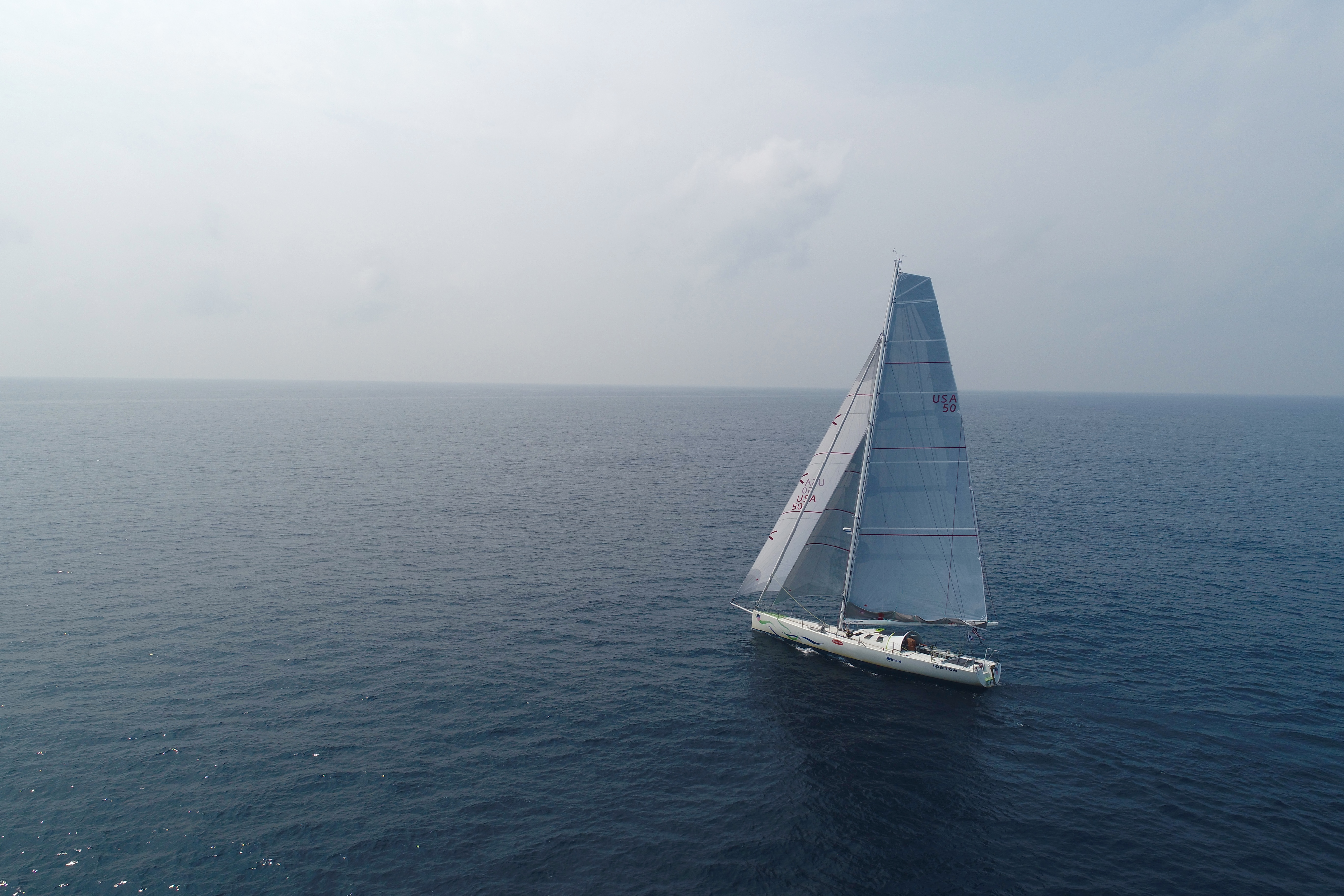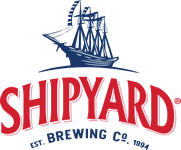 LINK TO TRACKER – https://share.garmin.com/5Q64H
LINK TO TRACKER – https://share.garmin.com/5Q64H
As I write this, I have just crossed the 500 nautical mile mark in my 2,000 mile solo qualifying passage. It’s been a struggle in really light and inconsistent breeze, but I am currently making quick and efficient miles towards my second mark on the course; Bermuda. This is fantastic sailing at the moment. The weather and navigation has been a real challenge during this leg of the trip, as a lingering and constantly shifting area of high pressure has been between the mouth of the Chesapeake/ Cape Hatteras and Bermuda. I have tried to navigate it as best I can, but it’s been a struggle and the daily runs and average speed have been nothing to write home about. This is not a surprise though, I knew I was leaving on a less than desirable window, but it was dictated by schedule. Still, we push on. I have about 275 miles to go to reach Bermuda, which I will go around and then begin heading back towards Cape Hatteras, before the final leg up to Maine. This will get me 2,000 miles sailed and if successfully completed, will qualify me for the Global Solo Challenge in October.
I had meant to update this before I left Solomons Island, but such is life… My last couple of days in Maryland were quite busy with preparations and also spending some time with a couple of friends who came to help me and also to wish me off. Thank you. After dinner on Tuesday night with Peter from US Patriot Sailing, I got back to the boat at 10:30 or 11 pm and was planning to leave early in the morning. As I laid down in my bunk however, I could feel that there was good breeze out and I knew the forecast was for it to go light during the following day, and so I decided to make final preparations and head out during the night. At midnight on Tuesday night/ Wednesday morning, I dropped my dock lines and motored out of Solomons Island. In the pitch black night, I went as slow as I could in forward and then got out of the harbor and pointed upwind to hoist the main. It was breezy, and so I hoisted just a double reefed main, thinking I could shake reefs once I got out there.
Cruising down the Bay at a modest speed, sailing downwind in 15-20 knots of breeze with a double reefed main, I began making good and cautious miles while keeping a very close watch out, since I was navigating the Chesapeake solo at night. Within the narrow confines of the Chesapeake, I had had the autopilot in compass heading mode to keep me in a straight line, and I was down below for a moment when the wind shifted quickly and I had my first ever crash gybe on the boat. With a very conservative sail plan and no head sail up or water ballast in, it was actually pretty mellow. I got the new runner on, the old one off, and then eased the main and switched the pilot to steer to a wind angle. I knew it was a matter of when, not if, I would crash gybe the boat. I definitely want to minimize how many times I do this, but it was probably good experience. Still, I really need to reigh in the mistakes. This boat and this race won’t be forgiving of mistakes.
As morning dawned, I was screaming along at points with just a main and jib. I flew the fractional zero for quite a ways down the Bay and also the masthead one too, furling and gybing multiple times. It was a lot of sail changes and maneuvers and after being up all day on Tuesday and then leaving without going to bed, I was becoming very tired and sleep deprived. Eventually the breeze died as forecast and I did a bit of motoring, which is legal during my qualifier. I mostly motor at a very mellow speed of about 3 knots, just to keep the boat moving and to sip fuel. Again, as forecast, the breeze built from the south and I short tacked my way out of the Chesapeake. At first I had full sail up, but as the breeze built I began to shorten sail so that I could handle the breeze, but also tack the boat easily. I have found that 2 reefs and a stay sail or full main and a stay sail is a good sail plan if you need to short tack. The big jib requires furling each time you tack, and then un-furling. And a main with 1 reef in it almost always gets fouled up in the runners when you tack. It got fairly breezy and since I had no water ballast in, I was powered up enough with 2 reefs and a stay sail, so I short tacked out of the Chesapeake with that sail plan. I had to cross a freighter’s bow at the moment I was sailing upwind out of the Bay. It was fairly intense and close, but it was day light and we had been in talks on the VHF radio. He wanted me to go starboard to starboard, but I wanted to stay on one tack and just blast out of the Bay, so I opted to not tack again and just take his bow.
Once out of the Bay and close to the Virginia shore, I tacked over to starboard in a southeasterly breeze and was making 8 knots due east and headed straight offshore. The breeze gradually declined and I added sail until some time in the super early morning, maybe 2 or 3 am when the wind died totally and I had to motor a bit in a rain front. The following morning I was downwind with a fractional zero for almost the whole day in very light air. Nice sailing, but very light and very slow. I have again had breeze a couple of times, but never for more than about 10-12 hours. And when it dies and shifts around a lot, it has mostly done it in the middle of the night, and so sleep has been a real challenge.
I am definitely not in racing mode. I am mostly just trying to test out all of the new gear, test out the boat, continue to learn the boat and the new gear, and also to make 2,000 miles without breaking anything. So far, so good for the most part. I have put up every sail but the mast head spinnaker and the storm jib. Things are mostly working well, though this is all a huge learning curve for me in seting the boat up and learning the boat and adapting my sailing to it. The other big mistake that I made that i’m really upset about is that I lost a nice spinnaker sheet that I liked very much. A couple of nights ago, I had the fractional zero up and a reef in the main and things started getting fairly spicy. The autopilot began to get a bit on edge (can still use some work), and it started to round us up. I caught it, and hand-steered us back under control and then decided to furl the code zero. Once the sail was furled and dropped on deck, I began cleaning up the sail and removing the furler and the sheets and going back to main and jib mode on the foredeck. I left the low side spinnaker sheet (the starboard side) unattached or tied off to anything, and the force of the water rushing by the boat took the sheet and ran it all out and off the boat. A simple mistake, I didn’t secure something even only for a minute, and it was gone. I was super upset, but I just need to reinforce the lesson that everything, always always always needs to be secured to the boat in some way or else it will be gone. In a 2,000 mile qualifier, I have a couple spares and can still make it to the finish, but in a race around the world, it will be super important to constantly preserve the life and possession of all equipment.
As of this writing, we are ripping along fairly good in a relatively narrow corridor of pressure where we are quite headed and able to jib reach at Bermuda at 8-10 knots of speed. We had the fractional kite up most of the morning and early afternoon until peeling to the jib.
506 miles down, 1,494 to go to reach my qualification. Current position is 34* 06 North, 69* 44 West, speed 8-10 and pointed rigth at Bermuda. Steadily getting a bit breezier, I may put a reef in, even if only for a couple hours until it goes lighter again. Still a challenging route to Bermuda with the weather, but the trip back to the east coast should be much, much quicker.
